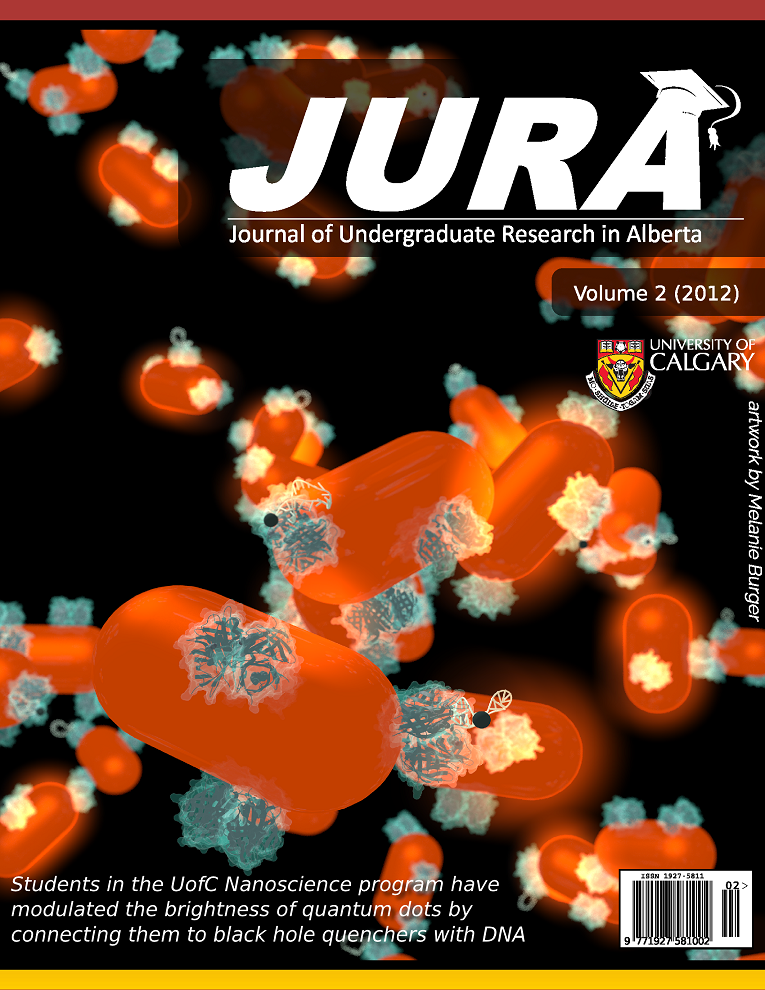Distance-dependent increase in quantum dot photoluminescence by molecular beacons containing dark quenchers
Keywords:
quantum dots, DNA, fluorescenceAbstract
Förster resonance energy transfer is a fluorescence-based technique currently used for numerous biotechnological applications. Although organic fluorophores have traditionally been employed for this method, quantum dots have many unique optical characteristics that make them attractive candidates for this usage. As the present understanding of how quantum dots behave as energy donors is incomplete, it is necessary to conduct further studies towards the physicochemical nature of this phenomenon. Here, we attempt to assess the distance- dependency for quantum dot-based energy transfer by spacing dark quenchers at increasing distances from these nanoparticles’ surfaces. We describe a surprising finding that quenchers can actually increase the average fluorescence intensity of quantum dot solutions, and we propose a theoretical explanation, which may allow others to more accurately conduct quantitative studies in the future.Downloads
Download data is not yet available.
References
1. Medintz, I. & Mattoussi, H. Quantum dot-based resonancy energy transfer and its growing application in biology. Phys.
Chem. Chem. Phys. 11, 17-45 (2009).
2. Kim, J.H., Chaudhary, S. & Ozkan, M. Multicolour hybrid nanoprobes of molecular beacon conjugated quantum
dots: FRET and gel electrophoresis assisted target DNA detection. Nanotechnology 18, 195105 (2007).
3. Li, Y. et al. Simultaneous detection of dual single-base mutations by capillary electrophoresis using quantum dot-molecular beacon probe. Biosens. Bioelectron. 26, 2317-2322 (2011).
4. Pons et al. On the quenching of semiconductor quantum dot photoluminescence by proximal gold nanoparticles. Nano Lett.7, 3157-3164 (2007).
5. Cady, N.C., Strickland, A.D. & Batt, C.A. Optimized linkage and quenching strategies for quantum dot molecular beacons. Mol. Cell. Probes 21, 116-124 (2007).
6. Dhawan, A., Sharma, V. & Parmar, D. Nanomaterials: A challenge for toxicologists. Nanotoxicology 3, 1-9 (2009).
7. Heuff, R.F., Swift, J.L. & Cramb, D.T. Fluorescence correlation spectroscopy using quantum dots: advances, challenges
and opportunities. Phys. Chem. Chem. Phys. 9, 1870-1880 (2007).
8. Yao et al. Blinking and nonradiant dark fraction of water-soluble quantum dots in aqueous solution. Proc. Natl. Acad. Sci.
102, 14284-14289 (2005).
9. Nguyen, T.T., Swift, J.L., Burger, M.C. & Cramb, D.T. Effects of various small-molecule anesthetics on vesicle fusion: A study using two-photon fluorescence cross-correlation spectroscopy. J. Phys. Chem. 113, 10357-10366 (2009).
Chem. Chem. Phys. 11, 17-45 (2009).
2. Kim, J.H., Chaudhary, S. & Ozkan, M. Multicolour hybrid nanoprobes of molecular beacon conjugated quantum
dots: FRET and gel electrophoresis assisted target DNA detection. Nanotechnology 18, 195105 (2007).
3. Li, Y. et al. Simultaneous detection of dual single-base mutations by capillary electrophoresis using quantum dot-molecular beacon probe. Biosens. Bioelectron. 26, 2317-2322 (2011).
4. Pons et al. On the quenching of semiconductor quantum dot photoluminescence by proximal gold nanoparticles. Nano Lett.7, 3157-3164 (2007).
5. Cady, N.C., Strickland, A.D. & Batt, C.A. Optimized linkage and quenching strategies for quantum dot molecular beacons. Mol. Cell. Probes 21, 116-124 (2007).
6. Dhawan, A., Sharma, V. & Parmar, D. Nanomaterials: A challenge for toxicologists. Nanotoxicology 3, 1-9 (2009).
7. Heuff, R.F., Swift, J.L. & Cramb, D.T. Fluorescence correlation spectroscopy using quantum dots: advances, challenges
and opportunities. Phys. Chem. Chem. Phys. 9, 1870-1880 (2007).
8. Yao et al. Blinking and nonradiant dark fraction of water-soluble quantum dots in aqueous solution. Proc. Natl. Acad. Sci.
102, 14284-14289 (2005).
9. Nguyen, T.T., Swift, J.L., Burger, M.C. & Cramb, D.T. Effects of various small-molecule anesthetics on vesicle fusion: A study using two-photon fluorescence cross-correlation spectroscopy. J. Phys. Chem. 113, 10357-10366 (2009).
Downloads
Additional Files
Published
2012-11-27
Issue
Section
Articles
License
Authors retain all rights to their research work. Articles may be submitted to and accepted in other journals subsequent to publishing in JURA. Our only condition is that articles cannot be used in another undergraduate journal. Authors must be aware, however, that professional journals may refuse articles submitted or accepted elsewhere—JURA included.


